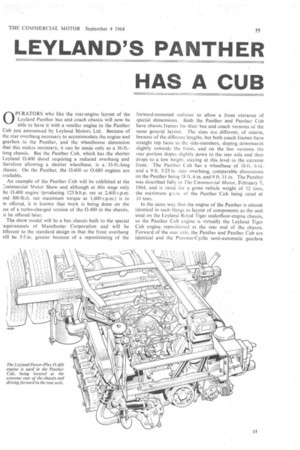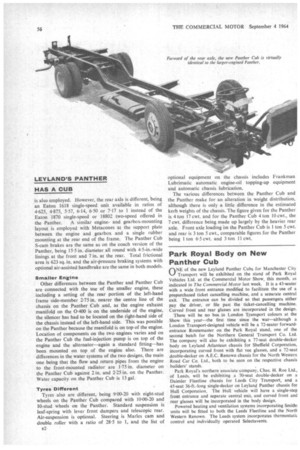LEYLAND'S PANTHER HAS A CUB
Page 57

Page 58

If you've noticed an error in this article please click here to report it so we can fix it.
OPERATORS who like the rear-engine layout of the Leyland Panther bus and coach chassis will now be able to have it with a smaller engine in the Panther Cub just announced by Leyland Motors Ltd. Because of the rear overhang necessary to accommodate the engine and gearbox in the Panther, and the wheelhouse dimension that this makes necessary, it can be made only as a 36-ft.tong chassis. But the Panther Cub, which has the shorter Leyland 0.400 diesel requiring a reduced overhang and therefore allowing a shorter wheelbase, is a .. 33-ft.-long :hassis. On the Panther, the 0.600 or 0.680 engines are tvailable.
An example of the Panther. Cub will be exhibited at the commercial Motor Show and although at this stage only be 0.400 engine (producing 125 b.h.p. net at 2,400 r.p.m. tnd 300 lb.ft, net maximum torque at 1,600 r.p.m.) is to )e offered, it is known that work is being done on the 1Se of a turbo-charged version of the 0.400 in the chassis, o be offered later.
The show model will be a bus chassis built to the special .equirernents of Manchester Corporation and will be iifferent to the standard design in that the front overhang vill be 5.5 in. greater because of a repositioning of the forward-mounted radiator to allow a front entrance of special dimensions. Both the Panther and Panther Cub have chassis frames for their bus and coach versions of the same general layout. The sizes are different, of course, because of the different lengths, but both coach frames have straight top faces to the side-members, sloping downwards slightly towards the front, and on the bus versions the rear portion slopes slightly down to the rear axle and then drops to a low height, staying at this level to the extreme front. The Panther Cub has a wheelbase of 16 ft. 6 in.' and a 9 ft. 3.25 in. rear overhang, comparable dimensions on the Panther being 18 ft. 6 in. and 9 ft. 11 in. The Panther was described fully in The Commercial Motor, February 7, 1964, and is rated for a gross vehicle Weight of 12 tons, the maximum g.v.w. of the Panther Cub being rated at 10 tons.
In the same way that the engine of the Panther is almost identical in such things as layout of components as the unit used on the Leyland Royal Tiger underfloor-engine chassis, so the Panther Cub engine is virtually the Leyland Tiger Cub engine repositioned at the rear end of the chassis. Forward of the rear axle, the Panther and Panther Cub are identical and the Pneumo-Cyclic semi-automatic gearbox
is also employed. However, the rear axle is different, being an Eaton 1618 single-speed unit available in ratios of 4.625, 4-875, 5-57, 6-14, 6.50 or 7-17 to 1 instead of the Eaton 1870 single-speed or 18802 two-speed offered in the Panther. A similar engineand gearbox-mounting layout is employed with Metacones at the support plate between the engine and gearbox and a single rubber mounting at the rear end of the frame. The Panther Cub S-cam brakes are the same as on the coach version of the Panther, being 15-5 in. diameter all round with 4-5-in.-wide linings at the front and 7 in. at the rear. Total frictional area is 623 sq. in. and the air-pressure braking systems with optional air-assisted handbrake are the same in both models.
Smaller Engine
Other differences between the Panther and Panther Cub are connected with the use of the smaller engine, these including a setting of the rear portion of the left-hand frame side-member 2-75 in. nearer the centre line of the chassis on the Panther Cub and, as the engine exhaust manifold on the 0-400 is on the underside of the engine, the silencer has had to be located on the right-hand side of the chassis instead of the left-hand side. This was possible on the Panther because the manifold is on top of the engine. Location of components on the two engines varies and on the Panther Cub the fuel-injection pump is on top of the engine and the alternator—again a standard fitting—has been mounted on top of the engine also. There are differences in the water systems of the two designs, the main one being that the flow and return pipes from the engine to the front-mounted radiator are 1-75 in. diameter on the Panther Cub against 2 in. and 2-25 in. on the Panther. Water capacity on the Panther Cub is 13 gal.
Tyres Different Tyres also are different, being 9.00-20 with eight-stud wheels on the Panther Cub compared with 10-00-20 and 10-stud wheels on the Panther. Standard suspension is leaf-spring with lever front dampers and telescopic rear. Air-suspension is optional. Steering is Marles cam and double roller with a ratio of 28-5 to 1, and the list of e/ optional equipment on the chassis includes Frankman Lubrimatic automatic engine-oil topping-up equipment and automatic chassis lubrication.
The various differences between the Panther Cub and the Panther make for an alteration in weight distribution, although there is only a little difference in the estimated kerb weights of the chassis. The figure given for the Panther is 4 ton 17 cwt. and for the Panther Cub 4 ton 10 cwt., the 7 cwt. difference being made up largely by the heavier rear axle. Front axle loading On the Panther Cub is 1 ton 5 cwt. and rear is 3 ton 5 cwt., comparable figures for the Panther being 1 ton 6-5 cwt. and 3 ton 11 cwt.
































































































































